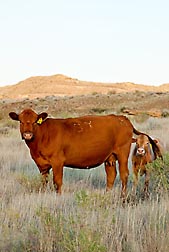This page has been archived and is being provided for reference purposes only. The page is no longer being updated, and therefore, links on the page may be invalid.
| Read the magazine story to find out more. |
|
|
USDA Study Shows Benefits of Weaning Calves Early
By Sandra AvantAugust 29, 2013
It pays to wean calves early when severe weather conditions like drought hinder beef cattle production, U.S. Department of Agriculture (USDA) studies confirm.
During drought, limited forage for livestock grazing can restrict calf growth, resulting in lighter calf weaning weights. Drought may also cause cows to lose body weight, and may weaken their immune functions, reducing their overall health and reproductive performance.
Animal scientist Richard Waterman, at the Agricultural Research Service (ARS) Fort Keogh Livestock and Range Research Laboratory (LARRL) in Miles City, Mont., examines management options to minimize the effects of severe drought on rangeland livestock production. ARS is USDA's principal intramural scientific research agency, and this research supports the USDA priority of promoting international food security.
Working with local ranchers, Montana State University scientists and American Simmental Association collaborators in Bozeman, Mont., Waterman evaluated the early weaning of beef calves and its impact on cow, heifer, and steer performance. Calves at two locations in Montana—Judith Gap and LARRL—were weaned early at 80 days of age and at the more traditional age of 215 days. Cows that weaned a calf early weighed more and were in better body condition at the start of winter. As a result, the amount of harvested feedstuffs required for cows to maintain satisfactory body weights and condition throughout winter was reduced.
Waterman confirmed that early weaning is a viable management option, presents fewer problems and allows producers to better control their production environment. He also demonstrated that early weaning increases the likelihood that heifers will become pregnant on time in the following breeding season.
Additional studies showed that early-weaned steers reached maturity sooner than traditionally weaned steers when body weight gain, feedlot performance and carcass traits were measured.
Waterman noted that management of early-weaned steers can directly impact how they grade at harvest. In some cases, early-weaned steers had poorer USDA yield grades because carcasses were too fat. However, Waterman demonstrated that producers can maximize carcass value of early-weaned steers if animals are identified before they enter the feedlot and then harvested at an earlier age.
Read more about this research in the August 2013 issue of Agricultural Research magazine.

